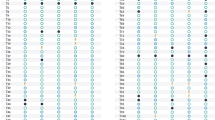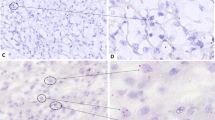Abstract
P53 tumour suppressor gene expression was estimated immunohistochemically using DO-1 monoclonal antibody (recognising both wild-type and mutant p53) in 88 human renal tumours. Single strand conformation polymorphism (SSCP) analysis of possible mutations within exons 4–8 of the p53 gene was performed in 29 of the tumours (mostly immunostaining-positive cases). Obviously elevated p53 content was detected with DO-1 antibody in chromophobic cell carcinomas and most clear/chromophilic cell tumours (in chromophilic cell populations). In contrast, clear cell carcinomas demonstrated either complete absence of p53 expression or the presence of single immunopositive nuclei. Oncocytomas were completely negative. Additional immunostaining of the positive samples with mutant p53-specific Pab240 monoclonal antibody failed to detect immunopositive material. No p53 mutation was found in any of the samples analysed by SSCP. Our results suggest that the elevated p53 content in human renal cell carcinomas does not result from gene mutation and that p53 gene alterations are probably not an important mechanism in the development of human renal cell carcinomas. Accumulation of the wild-type p53 protein may be a useful prognostic marker indicating neoplastic progression and malignancy.
Similar content being viewed by others
References
Ahn YS, Zerban H, Grobholz R, Bannasch P (1992) Sequential changes in glycogen content, expression of glucose transporters and enzymic patterns during development of clear/acidophilic cell tumors in rat kidney. Carcinogenesis 13:2329–2334
Ali IU, Schweitzer JB, Ikejiri B, Saxena A, Robertson JT, Oldfield EH (1994) Heterogeneity of subcellular localization of p53 protein in human glioblastomas. Cancer Res 54:1–5
Anglard P, Trahan E, Liu S, Latif F, Merino MJ, Lerman MI, Zbar B, Linehan WM (1992) Molecular and cellular characterization of human renal cell carcinoma cell lines. Cancer Res 52:348–356
Bannasch P, Zerban H (1990) Animal models and renal carcinogenesis. In: Eble JN (ed) Tumors and tumor-like conditions of the kidneys and ureters. Churchill Livingstone, New York, pp 1–34
Baretton G, Kuhlmann B, Krech R, Löhrs U (1991) Intratumoural heterogeneity of nuclear DNA-content and proliferation in clear cell type carcinomas of the kidney. Virchows Arch [B] 61:57–63
Bennett WP, Hollstein MC, He A, Zhu SM, Resau JH, Trump BF, Metcalf RA, Welsh JA, Midgley C, Lane DP, Harris CC (1991) Archival analysis of p53 genetic and protein alterations in Chinese esophageal cancer. Oncogene 6:1779–1784
Chen C-Y, Oliner JD, Zhan Q, Fornace AJ, Vogelstein B, Kastan MB (1994) Interactions between p53 and MDM2 in a mammalian cell cycle checkpoint pathway. Proc Natl Acad Sci USA 91:2684–2688
Delahunt B, Nacey JN (1987) Renal cell carcinoma. II. Histological indicators of prognosis. Pathology 19:258–263
Donehower LA, Bradley A (1993) The tumor suppressor p53. Biochim Biophys Acta 1155:181–205
Finlay CA, Hinds PW, Tan T-H, Eliyahu D, Oren M, Levine AJ (1988) Activating mutations for transformation by p53 produce a gene product that forms an hcs 70-p53 complex with an altered half-life. Mol Cell Biol 8:531–539
Fritsche M, Haessler C, Brandner G (1993) Induction of nuclear accumulation of the tumor-suppressor protein p53 by DNA-damaging agents. Oncogene 8:307–318
Fuhrman SA, Lasky LC, Limas C (1982) Prognostic significance of morphologic parameters in renal cell carcinoma. Am J Surg Pathol 6:655–663
Gannon JV, Greaves R, Iggo R, Lane DP (1990) Activating mutations in p53 produce a common conformational effect. A monoclonal antibody specific for the mutant form. EMBO J 9:1595–1602
Gelb AB, Shibuya RB, Weiss LM, Medeiros LJ (1993) Stage I renal cell carcinoma: a clinicopathologic study of 82 cases. Am J Surg Pathol 17:275–286
Hall PA, Lane DG (1994) p53 in tumor pathology: can we trust immunohistochemistry? J Pathol (Lond) 172:1–4
Hollstein M, Sidransky D, Vogelstein B, Harris CC (1991) p53 mutations in human cancers. Science 253:49–53
Iggo R, Gatter K, Bartek J, Lane D, Harris AL (1990) Increased expression of mutant form of p53 oncogene in primary lung cancer. Lancet 335:675–679
Imai S, Kiyozuka Y, Nishimura H, Iwanaga S, Murakami F, Imamura K, Noda T, Haga S, Yakushiji M (1994) Overexpression of the tumor suppressor gene p53 in human ovarian tumor tissues and its correlation with clinical stage. Int J Oncol 4:1097–1103
Kikuchi Y, Kishi T, Suzuki M, Furusato M, Aizawa S (1994) Polymerase chain reaction — single strand conformation polymorphism analysis of the p53 gene in paraffin-embedded surgical material from human renal cell carcinomas. Virchows Arch 424:229–233
Kovacs G (1993) Molecular differential pathology of renal cell tumors. Histopathology 22:1–8
Kovacs A, Störkel S, Thoenes W, Kovacs G (1992) Mitochondrial and chromosomal DNA alterations in human chromophobe renal cell carcinomas. J Pathol (Lond) 167:273–277
Kress S, Jahn U-R, Buchmann A, Bannasch P, Schwarz M (1992) p53 mutations in human hepatocellular carcinomas from Germany. Cancer Res 52:3220–3223
Kress S, König J, Schweizer J, Löhrke H, Bauer-Hoffman R, Schwarz M (1992) p53 mutations are absent from carcinogeninduced mouse liver tumors but occur in cell lines established from these tumors. Mol Carcinog 6:148–158
Levine AJ, Perry ME, Chang A, Silver A, Dittmer D, Wu M, Welsh D (1994) The 1993 Walter Hubert Lecture: The role of the p53 tumour-suppressor gene in tumorigenesis. Br J Cancer 69:409–416
Makos M, Nelkin BD, Reiter ER, Gnarra JR, Brooks J, Isaaks W, Linehan M, Baylin SB (1993) Regional DNA hypermethylation at D17S5 precedes 17p structural changes in the progression of renal tumors. Cancer Res 53:2719–2722
Maruyama K, Shiozaki H, Shimaya K, Inoue M, Iwazawa T, Matsui S, Mori T (1994) p53 expression in esophageal dysplasia: a possible biomarker for carcinogenesis of esophageal squamous cell carcinoma. Int J Oncol 4:1061–1065
Mayall FG, Goddard H, Gibbs AR (1992) p53 immunostaining in the distinction between benign and malignant mesothelial proliferation using formalin-fixed paraffin sections. J Pathol (Lond) 168:377–381
Momand J, Zambetti GP, Olson DC, George D, Levine AJ (1992) The mdm2 oncogene product forms a complex with the p53 protein and inhibits p53-mediated transactivation. Cell 69:1237–1245
Ogawa O, Habuchi T, Kakehi Y, Koshiba M, Sugiyama T, Yoshida O (1992) Allelic losses of chromosome 17p in human renal cell carcinoma are inversely related to allelic losses at chromosome 3p. Cancer Res 52:1881–1885
Oka K, Ishikawa J, Bruner JM, Takahashi R, Saya H (1991) Detection of loss of heterozygosity in the p53 gene in renal cell carcinoma and bladder cancer using the polymerase chain reaction. Mol Carcinog 4:10–13
Oliner JD, Kinzler KW, Meltzer PS, George DL, Vogelstein B (1992) Amplification of a gene encoding a p53-associated protein in human sarcomas. Nature 358:80–83
Oren M (1992) p53: the ultimate tumor suppressor gene? FASEB J 6:3169–3176
Orita M, Suzuki Y, Sekiya T, Hayashi K (1989) Rapid and sensitive detection of point mutations and DNA polymorphisms using the polymerase chain reaction. Genomics 5:874–879
Ortmann M, Vierbuchen M, Koller G, Fischer R (1988) Renal oncocytoma. I. Cytochrome C oxidase in normal and neoplastic renal tissue as detected by immunohistochemistry — a valuable aid to distinguish oncocytoma from renal cell carcinoma. Virchows Arch [B] 56:165–173
Pavelic ZP, Gluckman JL, Gapany M, Reising J, Craven JM, Kelley D, Pavelich L, Gapany S, Biddinger P, Stambrook PJ (1992) Improved immunohistochemical detection of p53 protein in paraffin-embedded tissues reveals elevated levels in most head and neck and lung carcinomas: correlation with clinicopathological parameters. Anticancer Res 12:1389–1394
Presti JC, Rao PH, Chen Q, Reuter VE, Li FP, Fair WR, Jhanwar SC (1991) Histopathological, cytogenetic, and molecular characterization of renal cortical tumors. Cancer Res 51:1544–1552
Reiter RE, Anglard P, Liu S, Gnarra JR, Linehan WM (1993) Chromosome 17p deletions and p53 mutations in renal cell carcinoma. Cancer Res 53:3092–3097
Rubio M-P, Deimling A von, Yandell DW, Wiestler OD, Gusella JF, Louis DN (1993) Accumulation of wild type p53 protein in human astrocytomas. Cancer Res 53:3465–3467
Schneider J, Rubio MP, Rodriguez-Escudero FJ, Seizinger BR, Castresana JS (1994) Identification of p53 mutations by means of single strand conformation polymorphism analysis in gynaecological tumours: comparison with the results of immunohistochemistry. Eur J Cancer 30A:504–508
Shi SR, Key ME, Kalra KL (1991) Antigen retrieval in formalin-fixed, paraffin-embedded tissues: an enhancement method for immunohistochemical staining based on microwave oven heating of tissue sections. J Histochem Cytochem 39:741–748
Soini Y, Turpeeniemi-Hujanen T, Kamel D, Autio-Harmainen H, Risteli J, Risteli L, Nuorva K, Pääkkö P, Vähäkangas K (1993) p53 immunohistochemistry in transitional cell carcinoma and dysplasia of the urinary bladder correlates with disease progression. Br J Cancer 68:1029–1035
Steinberg P, Störkel S, Oesch F, Thoenes W (1992) Carbohydrate metabolism in human renal clear cell carcinomas. Lab Invest 67:506–511
Störkel S (1993) Karzinome und Onkozytome der Niere. Fischer, Stuttgart
Suzuki Y, Tamura G, Satodate R, Fujioka T (1993) Infrequent mutation of p53 gene in human renal cell carcinoma detected by polymerase chain reaction — single stranded conformation polymorphism analysis. Jpn J Cancer Res 83:233–235
Thoenes W, Störkel S, Rumpelt HJ (1986) Histopathology and classification of renal cell tumors (adenomas, oncocytomas and carcinomas). The basic cytological and histopathological elements and their use for diagnostics. Pathol Res Pract 181:125–143
Tominaga O, Hamelin R, Trouvat V, Salmon RJ, Lesec G, Thomas G, Remvikos Y (1993) Frequently elevated content of immunochemically defined wild-type p53 protein in colorectal adenomas. Oncogene 8:2653–2658
Uhlman DL, Nguyen PL, Manivel JC, Aeppli D, Resnick JM, Fraley EE, Zhang G, Niehans GA (1994) Association of immunohistochemical staining for p53 with metastatic progression and poor survival in patients with renal cell carcinoma. J Natl Cancer Inst 86:1470–1475
Van den Berg FM, Tigges AJ, Schipper MEI, den Harton-Jager FCA, Kroes WGM, Walboomers JMM (1989) Expression of the nuclear oncogene p53 in colon tumors. J Pathol (Lond) 157:193–199
Van den Berg E, Van der Hout AH, Oosterhuis JW, Störkel S, Dijkhuizen T, Dam A, Zweers HMM, Mensink HJA, Buys CHCM, de Jong B (1993) Cytogenetic analysis of epithelial renal-cell tumors: relationship with a new histopathological classification. Int J Cancer 55:223–227
Vogelstein B, Kinzler KW (1992) p53 finction and dysfunction. Cell 70:523–526
Wadayama B, Toguchida J, Yamaguchi T, Sasaki MS, Kotoura Y, Yamamuro T (1993) p53 expression and its relationship to DNA alterations in bone and soft tissue sarcomas. Br J Cancer 68:1134–1139
Yonemura Y, Fushida S, Tsugawa K, Ninomiya I, Fonseca L, Yamaguchi A, Miyazaki I, Urano T, Shiku H (1993) Correlation of p53 expression and proliferative activity in gastric cancer. Anal Cell Pathol 5:277–288
Zbar B, Brauch H, Talmadge C, Linehan M (1987) Loss of alleles of loci on the short arm of chromosome 3 in renal cell carcinoma. Nature 327:721–727
Author information
Authors and Affiliations
Rights and permissions
About this article
Cite this article
Chemeris, G., Rempel, A., Bannasch, P. et al. Elevated content of p53 protein in the absence of p53 gene mutations as a possible prognostic marker for human renal cell tumors. Vichows Archiv A Pathol Anat 426, 563–569 (1995). https://doi.org/10.1007/BF00192110
Received:
Accepted:
Issue Date:
DOI: https://doi.org/10.1007/BF00192110




